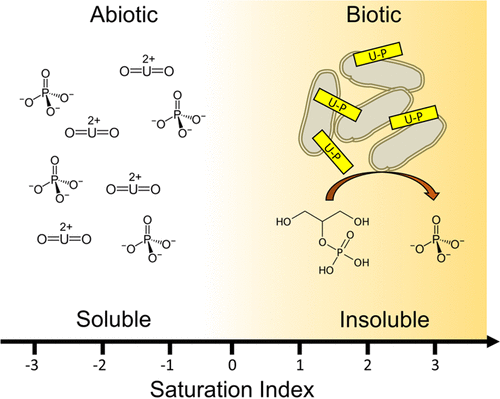当前位置:
X-MOL 学术
›
Environ. Sci. Technol.
›
论文详情
Our official English website, www.x-mol.net, welcomes your
feedback! (Note: you will need to create a separate account there.)
Influence of Uranium Concentration and pH on U-Phosphate Biomineralization by Caulobacter OR37
Environmental Science & Technology ( IF 10.8 ) Pub Date : 2021-01-20 , DOI: 10.1021/acs.est.0c05437 Keith D. Morrison , Mavrik Zavarin , Annie B. Kersting , James D. Begg , Harris E. Mason , Enrica Balboni , Yongqin Jiao
Environmental Science & Technology ( IF 10.8 ) Pub Date : 2021-01-20 , DOI: 10.1021/acs.est.0c05437 Keith D. Morrison , Mavrik Zavarin , Annie B. Kersting , James D. Begg , Harris E. Mason , Enrica Balboni , Yongqin Jiao

|
Uranium contamination of soils and groundwater in the United States represents a significant health risk and will require multiple remediation approaches. Microbial phosphatase activity coupled to the addition of an organic P source has recently been studied as a remediation strategy that provides an extended release of inorganic P (Pi) into U-contaminated sites, resulting in the precipitation of meta-autunite minerals. Previous laboratory- and field-based biomineralization studies have investigated environments with relatively high U concentrations (>20 μM). However, most contaminated sites have much lower U concentrations (<2 μM). The Environmental Protection Agency (EPA) limit for U in drinking water is 0.126 μM. Reaching this regulatory limit becomes challenging as U concentrations approach autunite solubility. We studied the precipitation of U(VI)-phosphate minerals by an environmental isolate of Caulobacter sp. (strain OR37) from an Oak Ridge, Tennessee, U-contaminated site. Abiotic U(VI) solubility experiments reveal that U(VI)-phosphate minerals do not form in the presence of excess Pi (500 μM) when U(VI) concentrations are <1 μM and pH is <5. When OR37 cells are reacted under the same conditions with Pi or glycerol-2-phosphate, U(VI)-phosphate mineral formation was observed, along with the formation of intracellular polyphosphate granules. These results show that bacteria provide supersaturated microenvironments needed for U(VI)-phosphate mineralization while hydrolyzing organic P sources. This provides a pathway to lower U concentrations to below EPA limits for drinking water.
中文翻译:

由铀的浓度和pH值对U型磷酸盐生物矿化的影响柄杆菌OR37
在美国,铀污染土壤和地下水代表着重大的健康风险,将需要采取多种补救措施。耦合到所述加入有机P源的微生物的磷酸酶活性,最近被研究作为一个补救策略,提供了无机P(PI)的延长释放到U形受污染场地,导致的析出元-铁矿物质。先前基于实验室和现场的生物矿化研究已经研究了U浓度相对较高(> 20μM)的环境。但是,大多数受污染的地点的U浓度要低得多(<2μM)。环境保护局(EPA)对饮用水中U的限量为0.126μM。随着U浓度接近金铁矿溶解度,达到此监管极限变得具有挑战性。我们研究了环孢细菌的环境分离物对U(VI)-磷酸盐矿物的沉淀sp。(菌株OR37)来自田纳西州橡树岭,受到U污染。非生物U(VI)溶解度实验表明,当U(VI)浓度<1μM和pH <5时,在过量的Pi(500μM)存在下不会形成U(VI)-磷酸盐矿物质。当OR37细胞在相同条件下与Pi或2-磷酸甘油酯反应时,观察到U(VI)-磷酸酯矿物质的形成,以及细胞内多磷酸盐颗粒的形成。这些结果表明,细菌提供了U(VI)-磷酸盐矿化所需的过饱和微环境,同时还水解了有机P源。这提供了将U浓度降低至EPA饮用水限值以下的途径。
更新日期:2021-02-02
中文翻译:

由铀的浓度和pH值对U型磷酸盐生物矿化的影响柄杆菌OR37
在美国,铀污染土壤和地下水代表着重大的健康风险,将需要采取多种补救措施。耦合到所述加入有机P源的微生物的磷酸酶活性,最近被研究作为一个补救策略,提供了无机P(PI)的延长释放到U形受污染场地,导致的析出元-铁矿物质。先前基于实验室和现场的生物矿化研究已经研究了U浓度相对较高(> 20μM)的环境。但是,大多数受污染的地点的U浓度要低得多(<2μM)。环境保护局(EPA)对饮用水中U的限量为0.126μM。随着U浓度接近金铁矿溶解度,达到此监管极限变得具有挑战性。我们研究了环孢细菌的环境分离物对U(VI)-磷酸盐矿物的沉淀sp。(菌株OR37)来自田纳西州橡树岭,受到U污染。非生物U(VI)溶解度实验表明,当U(VI)浓度<1μM和pH <5时,在过量的Pi(500μM)存在下不会形成U(VI)-磷酸盐矿物质。当OR37细胞在相同条件下与Pi或2-磷酸甘油酯反应时,观察到U(VI)-磷酸酯矿物质的形成,以及细胞内多磷酸盐颗粒的形成。这些结果表明,细菌提供了U(VI)-磷酸盐矿化所需的过饱和微环境,同时还水解了有机P源。这提供了将U浓度降低至EPA饮用水限值以下的途径。











































 京公网安备 11010802027423号
京公网安备 11010802027423号